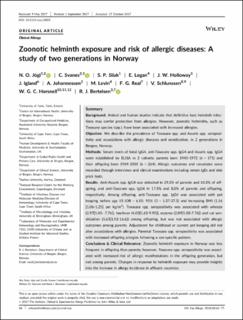| dc.contributor.author | Jögi, Nils Oskar | |
| dc.contributor.author | Svanes, Cecilie | |
| dc.contributor.author | Siiak, Silver Peeter | |
| dc.contributor.author | Logan, Erin | |
| dc.contributor.author | Holloway, John W. | |
| dc.contributor.author | Igland, Jannicke | |
| dc.contributor.author | Johannessen, Ane | |
| dc.contributor.author | Levin, Michael E. | |
| dc.contributor.author | Gomez Real, Francisco | |
| dc.contributor.author | Schlünssen, Vivi | |
| dc.contributor.author | Horsnell, William G.C. | |
| dc.contributor.author | Bertelsen, Randi Jacobsen | |
| dc.date.accessioned | 2022-09-12T12:00:44Z | |
| dc.date.available | 2022-09-12T12:00:44Z | |
| dc.date.created | 2018-05-27T14:15:48Z | |
| dc.date.issued | 2018 | |
| dc.identifier.issn | 0954-7894 | |
| dc.identifier.uri | https://hdl.handle.net/11250/3017260 | |
| dc.description.abstract | Background
Animal and human studies indicate that definitive host helminth infections may confer protection from allergies. However, zoonotic helminths, such as Toxocara species (spp.), have been associated with increased allergies.
Objective
We describe the prevalence of Toxocara spp. and Ascaris spp. seropositivity and associations with allergic diseases and sensitization, in 2 generations in Bergen, Norway.
Methods
Serum levels of total IgG4, anti-Toxocara spp. IgG4 and Ascaris spp. IgG4 were established by ELISA in 2 cohorts: parents born 1945-1972 (n = 171) and their offspring born 1969-2003 (n = 264). Allergic outcomes and covariates were recorded through interviews and clinical examinations including serum IgEs and skin prick tests.
Results
Anti-Ascaris spp. IgG4 was detected in 29.2% of parents and 10.3% of offspring, and anti-Toxocara spp. IgG4 in 17.5% and 8.0% of parents and offspring, respectively. Among offspring, anti-Toxocara spp. IgG4 was associated with pet keeping before age 15 (OR = 6.15; 95% CI = 1.37-27.5) and increasing BMI (1.16[1.06-1.25] per kg/m2). Toxocara spp. seropositivity was associated with wheeze (2.97[1.45- 7.76]), hayfever (4.03[1.63-9.95]), eczema (2.89[1.08-7.76]) and cat sensitization (5.65[1.92-16.6]) among offspring, but was not associated with allergic outcomes among parents. Adjustment for childhood or current pet keeping did not alter associations with allergies. Parental Toxocara spp. seropositivity was associated with increased offspring allergies following a sex-specific pattern.
Conclusions & Clinical Relevance
Zoonotic helminth exposure in Norway was less frequent in offspring than parents; however, Toxocara spp. seropositivity was associated with increased risk of allergic manifestations in the offspring generation, but not among parents. Changes in response to helminth exposure may provide insights into the increase in allergy incidence in affluent countries. | en_US |
| dc.language.iso | eng | en_US |
| dc.publisher | Wiley | en_US |
| dc.rights | Attribution-NonCommercial-NoDerivatives 4.0 Internasjonal | * |
| dc.rights.uri | http://creativecommons.org/licenses/by-nc-nd/4.0/deed.no | * |
| dc.title | Zoonotic helminth exposure and risk of allergic diseases: A study of two generations in Norway | en_US |
| dc.type | Journal article | en_US |
| dc.type | Peer reviewed | en_US |
| dc.description.version | publishedVersion | en_US |
| dc.rights.holder | Copyright 2017 The Authors | en_US |
| cristin.ispublished | true | |
| cristin.fulltext | original | |
| cristin.qualitycode | 1 | |
| dc.identifier.doi | 10.1111/cea.13055 | |
| dc.identifier.cristin | 1586989 | |
| dc.source.journal | Clinical and Experimental Allergy | en_US |
| dc.source.pagenumber | 66-77 | en_US |
| dc.identifier.citation | Clinical and Experimental Allergy. 2018, 48 (1), 66-77. | en_US |
| dc.source.volume | 48 | en_US |
| dc.source.issue | 1 | en_US |

